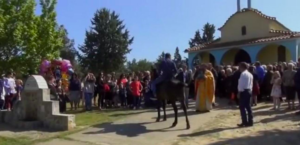For Orthodox Christians, Easter symbolises the rejuvenation of nature, akin to the arrival of Spring, where vibrant colors and fragrances fill the air with the blossoming of flowers. With the guidance of Fani Kalokairinou, the Scientific Director of the Folklore Historical Museum of Larissa, we delve into tradition to explore the intertwined concepts of Easter and Spring.
For Orthodoxy, Easter marks the culmination of Lent, a time of physical and spiritual preparation. Pre-Christian rituals, now part of Christian worship, symbolise death and resurrection, reflecting human efforts to hasten nature’s renewal for a good harvest. In Thessaly, as Easter approached, homes underwent renewal rituals, including whitewashing and cleaning. Local customs, like Lazarus Saturday and Lazarines in Elassona, added vibrancy to the celebrations. The multicultural nature of Larissa’s region enriched Easter traditions, which reflects nature’s rebirth and fertility.
The Archbishop Hieronymus’s Easter message – History is still captive to evil
Saint George, the patron saint of farmers, is celebrated near Easter, often on the second day, with various customs observed throughout Thessaly. In Kastraki Kalambaka, the custom of “mantilades” is particularly prominent. Legend has it that a Turkish officer fell unconscious while cutting trees in Saint George’s grove. His wife, in desperation, offered her scarf to the saint for her husband’s recovery. Miraculously, he regained consciousness when the scarf was hung in front of the icon. After the ritual, climbers descend wearing old scarves from the previous year, distributing them as blessings to all present.

Since ancient times, the people of Keramidio in Magnesia have revered Saint George, maintaining a longstanding custom. On the eve of his feast day, local farmers offer abundant sacrifices of sheep and cattle to the church, continuing the tradition of lamb sacrifices. Preparations for the “meal of Saint George” commence the night before, with villagers cooking a traditional recipe consisting of meat, onions, spices, and other ingredients, symbolizing the custom of sacrificing a bull.
Mrs. Fani Kalokairinou discusses the celebration of Saint George in Thessaly, where he is honored as the patron saint of livestock populations. Connected to Easter and spring, his feast typically aligns with the second day of Easter. He’s revered by mobile livestock breeders like the Vlachs and Sarakatsani, who consider him their patron saint. Saint George also protects rural communities and ensures agricultural prosperity. Additionally, he’s associated with ensuring clean drinking water, symbolizing his victory over a thirst-inducing dragon. Celebrations of Saint George occur across Thessaly, including in Pyrgetos and Gonnos in the Larissa region, and Makrychori, where the custom of the horsemen is observed.
Ask me anything
Explore related questions





